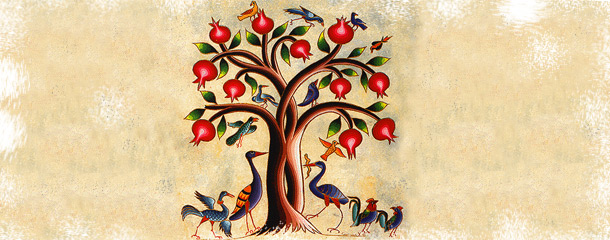
Where does the Pomegranate come from?
Pomegranate is one of the “seven kinds” mentioned in the Bible which Israel was blessed with long ago. It grew in the region for thousands of years and is very much adapted to it: it sheds its leaves in the cold of our winters, while it sprouts in early spring when temperatures rise. It ripens at the end of the summer, very close to the beginning of the Jewish New Year. It was and is used for decoration and blessings in ceremonies of the New Year celebrations and the later holidays. It decorated temples in the past and appeared on ancient coins.
Because of its decorative value in Israel, its selection was done mainly for external appearance, not so much for eating quality. Nice color and crown are very important characteristics of the fruit.
Origin and Distribution
The pomegranate tree is native from Iran to the Himalayas in northern India and has been cultivated since ancient times throughout the Mediterranean region of Asia, Africa and Europe. The fruit was used in many ways as it is today and was featured in Egyptian mythology and art, praised in the Old Testament of the Bible and in the Babylonian Talmud, and it was carried by desert caravans for the sake of its thirst-quenching juice. It traveled to central and southern India from Iran about the first century A.D. and was reported growing in Indonesia in 1416. It has been widely cultivated throughout India and drier parts of southeast Asia, Malaya, the East Indies and tropical Africa. The most important growing regions are Egypt, China, Afghanistan, Pakistan, Bangladesh, Iran, Iraq, India, Burma and Saudi Arabia. There are some commercial orchards in Israel on the coastal plain and in the Jordan Valley.
It is rather commonly planted and has become naturalized in Bermuda where it was first recorded in 1621, but only occasionally seen in the Bahamas, West Indies and warm areas of South and Central America. Many people grow it at cool altitudes in the interior of Honduras. In Mexico it is frequently planted, and it is sometimes found in gardens in Hawaii. The tree was introduced in California by Spanish settlers in 1769. It is grown for its fruit mostly in the dry zones of that state and Arizona. In California, commercial pomegranate cultivation is concentrated in Tulare, Fresno and Kern counties, with small farms in Imperial and Riverside counties. There were 2,000 acres (810 ha) of hearing trees in these areas in the 1920’s. Production declined from lack of demand in the 1930’s but new farms were made when demand increased in the 1960’s.
The inner beauty of the pomegranate has inspired design since Biblical times, and there are some who believe it may be the fruit on the tree of life.
History of the Pomegranate
As befits a fruit with many seeds, the pomegranate is the traditional representation of fertility, and seems to have its origins everywhere. We see it in the Middle East and India. The pomegranate was cultivated in Egypt before the time of Moses. It was found in the Indus valley so early that there is a word in Sanskrit for pomegranate. Indian royalty began their banquets with pomegranate, grape, and jujube. Arab caravans, many emanating from the lush oasis that was ancient Baghdad, probably spread its use.
The pomegranate is significant in Jewish custom. Tradition holds that a pomegranate has 613 seeds to represent the 613 commandments in the Torah. The design of the pomegranate was woven into the high priest’s robes, and brass representations were part of the Temple’s pillars. It is mentioned six times inch Song of Solomon. We see the pomegranate again in ancient Greece and Rome. In the verses of the Odyssey, Homer mentions it as part of the gardens of Alcinous (probably in Sicily). The Romans imported their pomegranates from African Libya, and Pliny the Elder gave instructions for its storage. Lest the pomegranate be neglected in the East, it appears in China during the Han and Sung dynasties.
The derivation of the word pomegranate comes from the Middle French pome garnete (seeded apple), but Europeans were slow to adopt the pomegranate. The pomegranate was probably introduced from Sicily, however Europeans, then under Norman influence, distrusted fruits and vegetables, preferring a meat-based diet. It is mentioned in the 14th century Ménagier de Paris which offered some recipes, and as we see in the quote from Romeo and Juliet it was known in England in Elizabethan times. The enthusiasm for pomegranate as a food was limited, but it was widely used as a decoration.
The Spanish Conquistadores brought the pomegranate to America. Jesuit missionaries carried it north to their missions in California. They were found growing wild in Georgia in 1772 .
